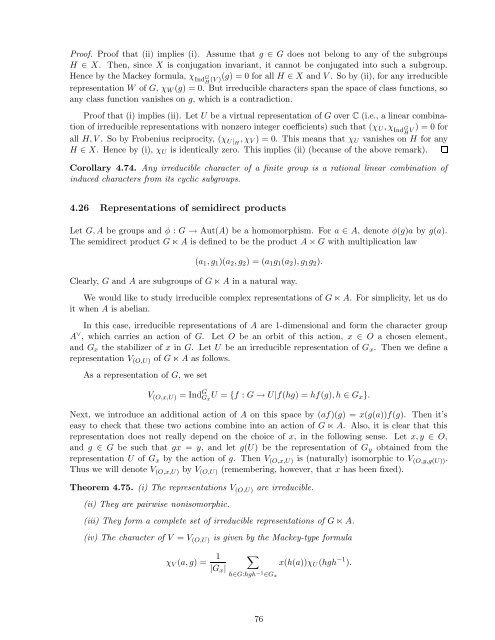Lecture notes for Introduction to Representation Theory
Lecture notes for Introduction to Representation Theory
Lecture notes for Introduction to Representation Theory
Create successful ePaper yourself
Turn your PDF publications into a flip-book with our unique Google optimized e-Paper software.
Proof. Proof that (ii) implies (i). Assume that g G does not belong <strong>to</strong> any of the subgroups<br />
H X. Then, since X is conjugation invariant, it cannot be conjugated in<strong>to</strong> such a subgroup.<br />
Hence by the Mackey <strong>for</strong>mula, ν Ind G (V )(g) = 0 <strong>for</strong> all H X and V . So by (ii), <strong>for</strong> any irreducible<br />
H<br />
representation W of G, ν W (g) = 0. But irreducible characters span the space of class functions, so<br />
any class function vanishes on g, which is a contradiction.<br />
Proof that (i) implies (ii). Let U be a virtual representation of G over C (i.e., a linear combination<br />
of irreducible representations with nonzero integer coefficients) such that (ν U , ν Ind G V ) = 0 <strong>for</strong><br />
H<br />
all H, V . So by Frobenius reciprocity, (ν U|H , ν V ) = 0. This means that ν U vanishes on H <strong>for</strong> any<br />
H X. Hence by (i), ν U is identically zero. This implies (ii) (because of the above remark).<br />
Corollary 4.74. Any irreducible character of a finite group is a rational linear combination of<br />
induced characters from its cyclic subgroups.<br />
4.26 <strong>Representation</strong>s of semidirect products<br />
Let G, A be groups and θ : G ⊃ Aut(A) be a homomorphism. For a A, denote θ(g)a by g(a).<br />
The semidirect product G ∼ A is defined <strong>to</strong> be the product A × G with multiplication law<br />
(a 1 , g 1 )(a 2 , g 2 ) = (a 1 g 1 (a 2 ), g 1 g 2 ).<br />
Clearly, G and A are subgroups of G ∼ A in a natural way.<br />
We would like <strong>to</strong> study irreducible complex representations of G ∼ A. For simplicity, let us do<br />
it when A is abelian.<br />
In this case, irreducible representations of A are 1-dimensional and <strong>for</strong>m the character group<br />
A ∗ , which carries an action of G. Let O be an orbit of this action, x O a chosen element,<br />
and G x the stabilizer of x in G. Let U be an irreducible representation of G x . Then we define a<br />
representation V (O,U) of G ∼ A as follows.<br />
As a representation of G, we set<br />
V (O,x,U) = Ind G U = {f : G ⊃ U|f(hg) = hf(g), h G x }.<br />
G x<br />
Next, we introduce an additional action of A on this space by (af)(g) = x(g(a))f(g). Then it’s<br />
easy <strong>to</strong> check that these two actions combine in<strong>to</strong> an action of G ∼ A. Also, it is clear that this<br />
representation does not really depend on the choice of x, in the following sense. Let x, y O,<br />
and g G be such that gx = y, and let g(U) be the representation of G y obtained from the<br />
representation U of G x by the action of g. Then V (O,x,U) is (naturally) isomorphic <strong>to</strong> V (O,y,g(U)) .<br />
Thus we will denote V (O,x,U) by V (O,U) (remembering, however, that x has been fixed).<br />
Theorem 4.75. (i) The representations V (O,U) are irreducible.<br />
(ii) They are pairwise nonisomorphic.<br />
(iii) They <strong>for</strong>m a complete set of irreducible representations of G ∼ A.<br />
(iv) The character of V = V (O,U) is given by the Mackey-type <strong>for</strong>mula<br />
ν V (a, g) =<br />
1 <br />
|G x |<br />
hG:hgh −1 G x<br />
x(h(a))ν U (hgh −1 ).<br />
76

















